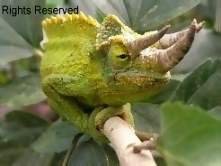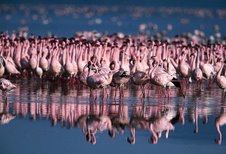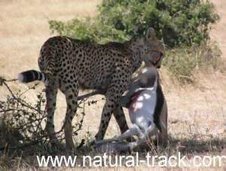If you have been following this series on the African wildlife Experience and what to expect in your Kenya safari then
here is some more great stuff for you. Our nature series this season
was features on an informative yet interesting coverage on the Leopard,
but a Cranston, a photographer whose love for nature is unending, had a
wonderful time in Lake Nakuru and Amboseli national parks heightened us
differently.
Right now as I speak, I am in Kenya, a country that
is perceived as; a wonderland of treasures, the cradle of mankind and
the land of contrasts. The greatest wonder of the world is now on as I
had told you earlier in the migration update and many visitors from all
over the world are streaming to Maasai Mara to have the first-hand
glimpse. Am talking about, the wildebeest migration.
I know you
might be wondering why I have to say all this stuff instead of going
directly to my point. Well! If I were a psychiatrist, I would have told
you "……… this is important as well" of which it is. But my main point
here is to prepare you on what to expect when in a safari.
If your
expectation of seeing the big five or monster lizard or even some
specific species of birds are met, there is always more to see and to
learn. Kenya as I said offers a diversity of attractions. That’s what
this series is about, so that you can know what Kenya and its diversity
has to offer.
This time we will talk about what's interesting about the world's tallest living mammal encountered a lot on Safari in Kenya.
The
giraffe is the world’s tallest terrestrial animal. It's one of the most
amazing animals especially because of the long neck that makes it
sometimes cumbersome and prone to a couple of problems that we shall see
as we proceed.
These African ruminant mammals, Giraffa
Camelopardalis, live in open savannahs south of the Sahara and have only
one family member, the Okapi. The reticulated giraffes are handsomely
patterned in golden browns, with a coarsely netted (reticulated) pattern
mainly quadrangular in shape. Males and females have stiff manes along
their necks and both sexes have horn-like structures called ossicones on
top of their heads between their ears. These ossicones are present at
birth in the form of small knobs of cartilage covered with skin and hair
which becomes bony nodules with age, and fuse to the skull with time.
Giraffes
are widely spread in Africa and Kenya in particular. As Cranston
witnessed, it's easy to spot the three species of giraffes in this part
of the world.
It amazes to know that giraffes despite being the
tallest mammal have seven vertebrae in their neck, the same with man and
most other mammals. Only that the vertebrae are much bigger. The tail
measures up to one yard with a terminal tuft of stiff, black hair.
They
have long tongues that measure 18-21 inches long. The inner part of the
tongue is pink in color, and then changes to a purplish-black color for
the last 6 inches that are commonly visible. ……… I wish you see them
browse on the acacias.
A quick look at the adaptations of the Giraffe
Giraffes
have long legs and neck, long, tough, prehensile tongue, and leathery
mouth for food gathering. Their coloration is protective. They are tall
with good eyesight for watchfulness. Giraffes have high blood pressure
(240/160) for pumping blood to the brain. Herds are small and loosely
constructed of 5-15 individuals, consisting of one bull with females and
young. Other bulls are solitary or in pairs.
Another interesting
thing about the giraffe is that they usually sleep standing up for only
1-12 minutes. Going for a month without water is also possible as an
adaptation to long drought periods in their native areas.
Giraffe is
browsing ruminant that eats regularly throughout the day, they prefer
young leaves and shoots at tops of acacia trees which sometimes ends up
shaping the regularly visited trees. They prefer to drink regularly, but
can go without water for several days and can run up to 35 mph.
Predators are leopards (prey on young), lions, and man. Giraffes kick
with their hooves and slam with their heads.
Off springs.....
Giraffes
are non-seasonal breeders, usually producing one calf after a gestation
period of 14-15 months. Newborn giraffe calves begin their lives by
falling up to about 6 feet to the ground, and weight 87-107 lbs. They
become sexually mature between 3 and 4 years of age and have a life span
of about 25 years and up to 30 in captivity. Full body size is not
reached until five years of age.
It is interesting to note that...
The
carotid artery that carries blood from the heart to the head is thick,
muscular and elastic, ballooning when the giraffe stoops to absorb
increase in pressure. When the giraffe raises its head, a series of
check valves in the inch-wide jugular vein prevents a sudden back flow
from the head, emptying the brain. They are most vulnerable to predators
when drinking or lying down. They may see red-orange, yellow-green,
purple, green and blue as colors. Their scientific name means
"camel-leopard-like one who walks swiftly." Their spot patterns are as
individual as fingerprints. They are among the very few mammals that
cannot swim at all.
Head/shoulder length is approximately 13' for the
male. Shoulder height is 8-12', overall height 15-19' and Weight is
1,100-2,800 lbs.
Giraffe’s have a variety of sounds but they are
rarely heard. They may grunt of snort when alarmed, females may whistle
to call their young, and calves can bleat
There are more to learn and
see in the giraffe especially the walking style but, I won't tell you
now until you make arrangements to see them. Almost every large park and
reserve in Kenya has at least one species. But for you, I would
recommend you take a safari to Samburu and see the most beautiful of the
three and then proceed to Lake Nakuru and see the largest of the three
yet the most endangered. From there you can voyage to Amboseli or Mara
and take pleasure in the look of the Kenyan named Maasai giraffe. An
extension to the coastal beaches of Kenya is fare as well…….
Next time we look on the leopard, probably the most beautiful cat ………… Join me then!!
PKP. Safaris in Kenya desk
Natural Track Safaris
Subscribe to:
Post Comments (Atom)









No comments:
Post a Comment